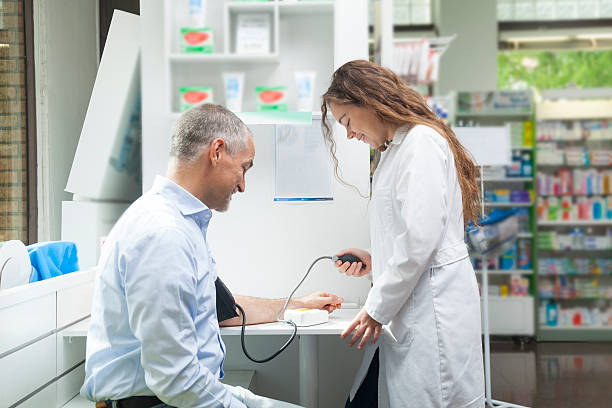The #1 Rated Blood Sugar Formula
Hypertension Diagnosis and Treatment

Your doctor can diagnose hypertension by checking your blood pressure. It is a very simple test that takes only a few minutes. Usually an inflatable upper arm cuff with a gauge is used. Your doctor or other medical professional will slide the blood pressure cuff to just above your elbow on your bare arm.
- Normal blood pressure. Your blood pressure is normal if it's below 120/80 mm Hg.
- Elevated blood pressure. Elevated blood pressure is a systolic pressure ranging from 120 to 129 mm Hg and a diastolic pressure below (not above) 80 mm Hg. Elevated blood pressure tends to get worse over time unless steps are taken to control blood pressure. Elevated blood pressure may also be called prehypertension.
- Stage 1 hypertension. Stage 1 hypertension is a systolic pressure ranging from 130 to 139 mm Hg or a diastolic pressure ranging from 80 to 89 mm Hg.
- Stage 2 hypertension. More-severe hypertension, stage 2 hypertension is a systolic pressure of 140 mm Hg or higher or a diastolic pressure of 90 mm Hg or higher.
- Hypertensive crisis. A blood pressure measurement higher than 180/120 mm Hg is an emergency situation that requires urgent medical care. If you get this result when you take your blood pressure at home, wait five minutes and retest. If your blood pressure is still this high, contact your doctor immediately.
Numbers in Blood Pressure
Both numbers in a blood pressure reading are important. But after age 50, the systolic reading is even more important. Isolated systolic hypertension is a condition in which the diastolic pressure is normal (less than 80 mm Hg) but systolic pressure is high (greater than or equal to 130 mm Hg). This is a common type of high blood pressure among people older than 65.Taking your blood pressure at home
Your doctor may ask you to record your blood pressure at home to provide additional information and confirm if you have high blood pressure. Home monitoring is an important way to confirm if you have high blood pressure, to check if your blood pressure treatment is working or to diagnose worsening high blood pressure. Home blood pressure monitors are widely available and inexpensive, and you don't need a prescription to buy one. Home blood pressure monitoring isn't a substitute for visits to your doctor, and home blood pressure monitors may have some limitations. Make sure to use a validated device, and check that the cuff fits. Bring the monitor with you to your doctor's office to check its accuracy once a year. Talk to your doctor about how to start checking your blood pressure at home.Tests
If you have high blood pressure, your doctor may recommend tests to confirm the diagnosis and check for underlying conditions that can cause hypertension.- Ambulatory monitoring. This 24-hour blood pressure monitoring test is used to confirm if you have high blood pressure. The device used for this test measures your blood pressure at regular intervals over a 24-hour period and provides a more accurate picture of blood pressure changes over an average day and night. However, these devices aren't available in all medical centers, and they may not be reimbursed.
- Lab tests. Your doctor may recommend a urine test (urinalysis) and blood tests, including a cholesterol test.
- Electrocardiogram (ECG or EKG). This quick and painless test measures your heart's electrical activity.
- Echocardiogram. Depending on your signs and symptoms and test results, your doctor may order an echocardiogram to check for more signs of heart disease. An echocardiogram uses sound waves to produce images of the heart.
Treatment
Changing your lifestyle can help control and manage high blood pressure. Your doctor may recommend that you make lifestyle changes including:- Eating a heart-healthy diet with less salt
- Getting regular physical activity
- Maintaining a healthy weight or losing weight if you're overweight or obese
- Limiting the amount of alcohol you drink
Medications
The type of medication your doctor prescribes for high blood pressure depends on your blood pressure measurements and overall health. Two or more blood pressure drugs often work better than one. Sometimes finding the most effective medication or combination of drugs is a matter of trial and error. You should aim for a blood pressure treatment goal of less than 130/80 mm Hg if:- You're a healthy adult age 65 or older
- You're a healthy adult younger than age 65 with a 10% or higher risk of developing cardiovascular disease in the next 10 years
- You have chronic kidney disease, diabetes or coronary artery disease
Treating resistant hypertension
If your blood pressure remains stubbornly high despite taking at least three different types of high blood pressure drugs, one of which usually should be a diuretic, you may have resistant hypertension. You're also considered to have resistant hypertension if you have controlled high blood pressure but are taking four different types of medications at the same time to achieve that control. If you do, your doctor should investigate the possibility of a secondary cause of the high blood pressure. Having resistant hypertension doesn't mean your blood pressure will never get lower. If you and your doctor can determine the cause, a more effective treatment plan can be created to help you meet your goal blood pressure. Treating resistant hypertension may involve many steps, including:- Changing your high blood pressure medications to determine which combinations and doses work best
- Reviewing all the medications you take, including those that you take for other conditions or buy without a prescription
- Monitoring your blood pressure at home to see if going to the doctor causes your blood pressure to increase (white coat hypertension)
- Making healthy lifestyle changes, such as eating a healthy diet with less salt, maintaining a healthy weight and limiting alcohol





